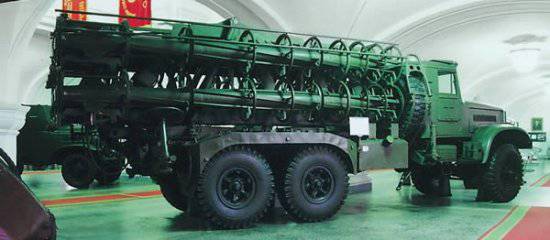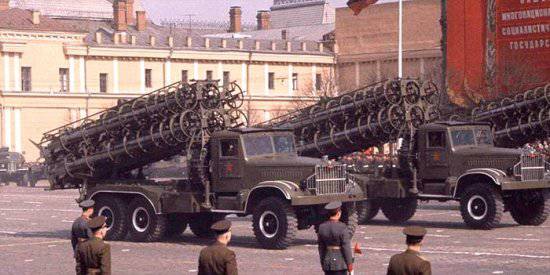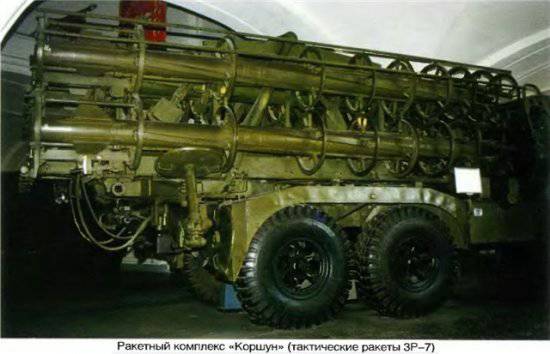2K5 Kite System
The Kite system 2K5 with a liquid unguided missile ZR7 was intended for hitting targets at ranges up to 55 km with powerful warheads of 100 mass to ;. A multiple increase in the mass of the warhead and the firing range, even with the use of high-energy liquid fuel, determined the almost double weighting of the Kite compared to MD-20.
Unlike the German Typhoon, in which the oxidizer tank concentrically covered the fuel tank, the Russian unguided missile ZR7 was made according to the traditional scheme with the sequential arrangement of triethylaminx-lidine tanks (TG-02, Tonka) and nitric acid. A cheaper version of the propulsion system was also developed using TG-02 only as a starting fuel, and a more affordable TM-130 - as the main one. As with many other 1950-x missiles, the squeeze-fed liquid fuel was used in the ZX7. which ensured the simplification and cheapening of the engine design at the cost of some weighting of the housings designed for high pressure tanks. However, on small rockets, the mass of the product design as a whole turned out to be quite acceptable given the slight relief of the engine due to the exclusion of the turbopump assembly from its composition.
In front of the missile was located the warhead. Inside the tail section there was a C3.25 liquid-propellant rocket engine (C3.25B in the version with main fuel TM-130), and a stabilizer was attached to the outer surface of the casing, four trapezoidal feathers of which were located at a slight angle to the incident flow, which ensured a roll over the roll for averaging the action of gas springs and aerodynamic perturbing forces.
To reduce aerodynamic drag and ease of placement on the combat vehicle, the body of the missile was made in large elongation. The length was 5535 mm with a diameter 250 mm.
"Kite" on parade
When the Korshun combat vehicle was placed on the ZIS-151 chassis that had already become standard for post-war volley fire systems or its modifications, it could not carry more than two ZR7 missiles weighing 385 kg. More favorable prospects were opened when using the YAZ-214 all-terrain chassis. developed at the beginning of the 1950's. After transferring the production of this car from Yaroslavl to Kremenchug, its name was changed to KrAZ-214. The Korshun 2P5 combat vehicle with 18,14 t mass could reach speed on the 55 highway km / h, the power reserve was 530 km. The package for placing six missiles on spiral guides could be displayed at an elevation angle up to 52 degrees. Horizontal guidance was carried out within the 6 angle hail The artillery part of the combat vehicle was developed in Leningrad at TsKB-34 under the symbol CM-55.
Extensive experience in creating anti-aircraft unguided rockets, combining the development of the rocket and the engine in one team of OKB-3, SRI-88, made it possible to quickly complete the stage of ground testing from the middle of the 1950s. move on to flight tests that have been fairly successful and confirmed the achievement of the specified indicators of the complex. A small series of combat vehicles was launched, from 1957 on display in parades on Red Square.
But in fact, the "Kite" did not enter service. The teams of Isayev and Sevruk, who worked on a competitive basis as part of the same organization - Scientific Research Institute-88, found themselves in a situation usually characterized as “two bears in one den”. Isaeva's more realistic technical policy prevailed, and at the end of 1958, the Sevruk team was poured into the OKB-2. The combined subdivision of SRI-88 received the name OKB-5 (OKB-2 + OKB-3), and at the beginning of the next year it was separated into a completely independent organization - OKB-2, which focused its activities on engine-building. As a result, after the team of OKB-1 JV. The queen practically all design divisions were allocated from scientific research institute-88. which, in full accordance with the name, has become a scientific organization of a theoretical and experimental profile. Sevruk himself returned to the organization Glushko.
Officially, the development of "Kite" was discontinued by the Decree of the Central Committee of the CPSU and the Council of Ministers of the USSR dated February 5 1960 135-48.
"KITE"
(Ural version)
In addition to SRI-88, SKB-385 was also involved in the development of the Korshun system at plant No. 66, located near the Ural city of Zlatoust. At the end of 1940's This enterprise was planned as the main manufacturer of the P-1 missiles - recreated by the JV team. Queen of the German V-2 and ballistic missiles, created in their development. When the plant in 1947 was created by the Bureau, headed by M.I. Duplischevym, with 1949, allocated in an independent SKB-385. However, at the beginning of the 1950's. it was decided to launch the production of the P-1 not in Zlatoust, but in Dnepropetrovsk. In the Urals, were conducted and experimental work on rocket science, but associated with not the most relevant topics. They developed the product "50PA" - all the same P-1, but using plywood instead of metal in the compartments. Later, these works were transferred to Dnepropetrovsk, and in Zlatoust they took up the Kite rocket - 8B51. Compared with the NII-88 variant, it was smaller — the length of 4 m at caliber 240 mm, which should have determined the worst tactical and technical characteristics. Naturally, the liquid rocket engine was not developed by a competitor - Sevruk, a AM Isaev, however, all worked in the same research institute-88. The single-chamber C2.260 engine also operated on nitric acid and kerosene. The displacing supply of the fuel components was provided using a powder pressure accumulator.
After the development of draft designs and a series of experimental works, the choice was made in favor of the Sev-ruka variant, and the work on 8B51 was stopped. However, when designing it, the experience of the SKB-385 commonwealth with the motor design bureau of Isaev was accumulated, which for many decades became the basis for cooperation between many organizations for creating liquid ballistic missiles for submarines, which later became the chief designer of these missiles V.P. Makeev, who led the SKB-385 in 1955



Information